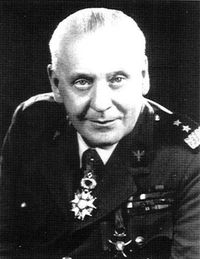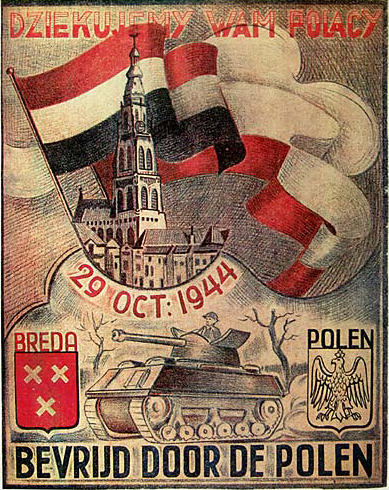Prominent Poles
Stanisław Władysław Maczek , Polish-British military man, Brigadier General (General broni), WWII hero

Born: March 31, 1892, Lwow,then Lemberg, Austro-Hungarian partition of Poland (presently Lviv, Ukraine)
Died: December 11, 1994, Edinburgh, United Kingdom
Summary. This is a poster from Breda, The Netherlands: We thank you, Poles

Early days.After graduating from a Drohobycz gymnasium in 1910, he studied Polish philology at the Lwów University. During his studies he joined the Strzelec paramilitary organization.
Military career.After the outbreak of WWI, Maczek wanted to join Piłsudski's Polish Legions, but instead was drafted to the Austro-Hungarian Army. After receiving brief training, Maczek was sent to the Italian front. Initially an NCO in the Tyrolean Regiment of the K.u.K. Army, he was promoted to the rank of 2nd Lieut. in 1916 and in 1918 to 1st Lieut. He gained much experience in mountain warfare. On November 11, 1918 Maczek disbanded his battalion and returned to newly-reborn Poland. Designated as the commander of a Krosno battalion, Maczek started a limited offensive against the forces of the West Ukrainian People's Republic (ZUNR). In April of 1919 Maczek was withdrawn from his unit and became the organizer and commander of the so-called volatile company (lotna kompania) within Gen. Aleksandrowicz's 4th Infantry Division. The unit, created on Maczek's inspiration and modeled after the German Sturmbatalionen of World War I, was almost entirely motorized and well-equipped with heavy machine guns. Its combat value was well above the average of the Polish Army of the time. Because of that it served both as a stop-gap "armed ambulance" filling the front in defensive operations and fought with distinction in the Polish spring offensive. It took part in some of the heaviest fights of the war, including the battles for Drohobycz, Stanisławów, Buczacz and finally ZUNR's capital, Stryj. After the end of the Polish-Ukrainian fights, Maczek was promoted to the rank of Major. He was then attached to Gen. Iwaszkiewicz's Polish 2nd Army as a staff officer. After the Polish-Bolshevik War started and the 2nd Army suffered a defeat in the initial clashes with Semyon Budyonny's 1st Cavalry Army Maczek formed a new volatile Rifle battalion, mostly composed of fresh recruits and horseless uhlans. His unit took part in the Polish assault on Waręż near Zamość, preceding the victorious battle of Komarów. After the end of hostilities Maczek did not resume his studies but remained in active service. Between 1921 and 1923 he was a commanding officer of an infantry battalion of the 26th Infantry Regiment. He was promoted to the rank of Lt.Col. and sent to the Higher Military School in Warsaw. He graduated in 1924 and until 1927 he served as the head of the 2nd Detachment of the General Staff (intelligence) in Lwów. Later that year he moved to Grodno, where he became the deputy commander of the 76th Infantry Regiment. In 1929, after finishing his training, he became the commander of the Grodno-based 81st Infantry Regiment and held that post until 1934. In 1931 he was promoted to the rank of Colonel. In 1935 he was moved to Częstochowa, where he became the deputy commander of the prestigious 1st Legions Infantry Division. In October of 1938 he was made the commander of the Polish 10th Motorized Cavalry Brigade, the first fully-motorized unit of the Polish Army. After the outbreak of WWII, the brigade was attached to the Kraków Army defending Lesser Poland (Malopolska) and Silesia. Equipped with only light tanks and tankettes and with only 8 heavier cannons, it went into battle already in the first day of war. After the Battle of Jordanów, Maczek's unit faced the entire German XVIII Corps and successfully shielded the southern flank of the Polish forces, along the Beskides. Supported by merely several battalions of Border Guards and National Defense, the Polish motorized unit fought against two panzer divisions, as well as the 3rd Mountain Division. For five days Maczek’s brigade fought bravely and very efficiently, changing German „blitzkrieg” into slow and bloody march. However, after the front of the Kraków Army was broken the brigade was pulled out from the first line. When it arrived to Lwów it joined the city’s defenders. It was to form a mobile reserve during the battle for Lwów and allow other Polish units to withdraw towards the Romanian Bridgehead. However, the plan was made obsolete by the invasion of Poland by the Soviet Union on September 17. After two days, Marshal of Poland Edward Rydz-Śmigły ordered the brigade to cross Hungarian border. Maczek’s brigade was interned in Hungary. The unit lost about half of its men, but was never defeated in open combat, gaining respect even from the enemy. It is considered to be the only Polish unit not to lose a single battle in 1939. After the end of the September campaign Maczek made it to France, where he joined the re-created Polish Army and was promoted to the rank of Brigadier General. He was made the commanding officer of the Polish military camp in Coëtquidan. He also started gathering all of the veterans of the 10th Brigade who made it to France in two camps in Painpont and Campeneac. However, initially the French command was not interested in formation of a Polish armored unit and the Polish 10th Armored Cavalry Brigade did not receive the necessary equipment. It was not until March of 1940 that Maczek received a dozen of obsolete FT-17 tanks, several dozen cars and motorcycles for training. Everything changed, when Germany invaded France in the spring of 1940. General Maczek's unit suddenly received all the equipment they had asked for, with one condition: they had to go into action immediately. That was impossible, because many Polish soldiers had no idea how to use the new equipment and there was no time for exercises. General Maczek decided to lead a small force of his best trained men, hoping that the rest of his unit would join them later. That small force was called 10th Armored Cavalry Brigade (10 Brygada Kawalerii Pancernej). On June 6, 10th Brigade had one tank battalion, two strong motorized cavalry squadrons, one anti-tank battery and one anti-aircraft battery. It was attached to French 4th Army near Reims, and was ordered to cover its left flank. However, Maczek's unit was much too weak to fight successfully against German armored divisions. Polish soldiers managed only to cover one retreating French infantry division by attacking German forces in Champaubert-Montgivroux. Later the brigade had to withdraw with the rest of French troops, and joined the French XXIII Corps. On June 16 the brigade attacked by night the town of Montbard over the Burgundy Canal. Maczek's soldiers completely surprised the Germans and took many prisoners. However, the brigade by then was fighting alone, with the French units on both flanks either routed or in retreat. There were no French forces to take advantage of that victory, and the decimated Polish unit found itself surrounded and without fuel. On June 18, general Maczek decided to destroy useless equipment and to withdraw on foot. Later that day he had to split the remnants of his brigade into small groups, so they could pass the enemy lines. Many of Maczek's men, including the general himself, found their way through Vichy France, North Africa and Portugal to the United Kingdom, where a Polish armored unit was recreated, while others joined the Polish and French resistance organizations in France and Belgium. Maczek arrived to London. Initially the British high command wanted to use the recreated Polish Army solely for defense of the coastline in Scotland between Aberdeen and Edinburgh, and the veterans of the Polish tank formations who arrived to the UK were pressed into the Polish 2nd Rifle Brigade under Gen. Rudolf Orlicz-Dreszer. However, immediately upon Maczek's arrival the idea was abandoned and Gen. Sikorski managed to convince the British government to create a Polish armored unit instead. After years of training at the Blairgowrie training ground, in February 1942, Gen. Maczek formed the 1st Polish Armored Division. Equipped by the British authorities with State-of-the-Art Churchill and M4 Sherman tanks, it initially served in defense of the Scottish shoreline between Montrose and Dundee. By the end of July 1944 the division has been transferred to Normandy. Attached to First Canadian Army, Maczek's men entered combat on August 8 during the Operation Totalize. The division twice suffered serious bombings by Allied aircraft yet it achieved a brilliant victory against the Wehrmacht in the battles for Mont Ormel, 262 Hill and the town of Chambois. This series of offensive and defensive operations came to be known as the Battle of Falaise in which 14 of German Wehrmacht and SS divisions were trapped in a huge Chambois pocket and subsequently destroyed. Maczek's division had the crucial role of closing the pocket at the escape route of those German divisions. After this decisive battle, Gen. Maczek's Division continued to spearhead the Allied drive across the battlefields of France, Belgium, Netherlands (Breda), and finally Germany. The Division's "moment of glory" came when its forces captured the German port of Wilhelmshaven and accepted the surrender of the entire garrison, which included some 200 vessels of Hitler's navy (Kriegsmarine). Gen. Maczek commanded the First Armored until the end of the hostilities in Europe, and was named Major General that same year. After the capitulation of Germany he went on to command the Polish I Corps and then became the commanding officer of all the Polish forces in the United Kingdom until their demobilization in 1947. After the war he was deprived of Polish citizenship by the Communist government of People's Republic of Poland and thus had to stay in Britain. As he was not considered an Allied soldier, the British authorities tragically declined him combatant rights and military pension. Until the sixties he worked as a bartender in a hotel in Edinburgh. He died December 11, 1994 at the age of 102. He is buried among his soldiers at the Polish military cemetery in Breda, the Netherlands. Each year during Liberation Day festivities, Breda is visited by a large Polish contingent and the city of Breda reserves a special portion of the festivities for the fallen Polish soldiers.
Source:
This article uses, among others, material from the Wikipedia article "Stanislaw Maczek" licensed under the GNU Free Documentation License. :
Wikipedia
All text is available under the terms of the GNU Free Documentation License.
Return to home page:
Prominent Poles

